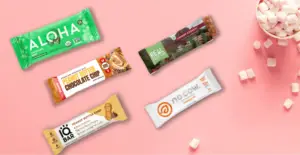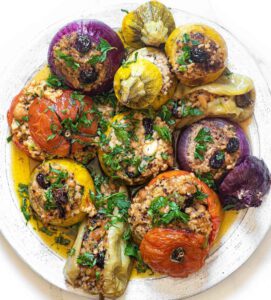So, you’ve gone vegan, or you’re thinking about taking the first steps into your plant-based journey. Congratulations! Now you’ve made the decision to live compassionately by adapting your lifestyle and diet, it’s time to learn how to do so healthily. After all, there are many incredible health benefits to eating a plant-based diet – and we’re here to help you unlock them with these vegan nutrition basics!
Vegan nutrition basics: Our bitesize guide
You may be thinking – isn’t cutting out animal products enough? Won’t I automatically feel healthier, happier and more energetic? Well, not necessarily. From ultra-processed vegan burgers to dairy-free cheese, many vegan products are kind to animals but not to the body!
The key to enjoying the many health benefits of a vegan diet is eating a diverse range of fresh, wholesome foods that offer the macro and micronutrients your body needs. Below, we make this easier than ever with our digestible guide to the nutrition basics every vegan should know!

Getting enough macronutrients & micronutrients on a vegan diet
Macronutrients
We know you’re not here for a science lesson, so we’ll put it simply – macronutrients are the nutrients you need lots of! There are three: protein, fat and carbohydrates.
Protein
Protein is composed of more than 20 amino acids, and there are just nine that your body can’t produce itself. As a result, you’ll need to obtain them from your diet.
There are two ways to do this:
- Consume plenty of plant-based complete proteins (i.e. ingredients containing all nine essential amino acids). Tofu, tempeh, quinoa, chia seeds and nutritional yeast all tick this box!
- Combine ingredients to create complete proteins. Tasty meal ideas include wholegrain bread with peanut butter, wholegrain bread with hummus, and brown rice with black beans.
You’ll find a range of protein-packed vegan recipes on Good Old Vegan, like our Hoisin Tempeh & Eggplant and Loaded Vegan Quinoa Wraps. Yum!
Fat
Eating the right types of fat is all part of enjoying a nourishing, balanced vegan diet. This means not relying too heavily on vegan convenience food, but cooking with more than just vegetables and whole grains.
Some of the most nutritionally valuable sources of healthy fat include avocados, coconuts, olives, peanuts, walnuts and sesame seeds.

Carbohydrates
It’s easy to eat plenty of carbohydrates on a vegan diet, as many nutrient-dense carbs are naturally vegan – including brown rice, quinoa, sweet potatoes and wholegrain bread. The key is to ensure you’re complementing a portion of carbohydrates with plenty of protein, healthy fats and vitamins!
If you’re looking for meal inspiration, why not try our Better Than Takeout Sesame Cauliflower, or perhaps our hearty Vegan Ramen Soup? Trust us, they’re delicious!
Micronutrients
Micronutrients are the minerals and vitamins that your body needs to function. Luckily, micronutrients are plentiful in plants! Many fruits and veggies are nutritional powerhouses, offering up lots of goodness in every serving.
Nevertheless, some vitamins and minerals need extra attention. Some aren’t represented well in plant sources, so you’ll need to plan your meals carefully to get enough of them on a vegan diet.
Let’s look at these in more detail.
Calcium
Many people believe that calcium only comes from dairy products, but this simply isn’t true! You can get plenty of calcium by consuming fortified vegan products, such as enriched plant milk and calcium-set tofu, alongside broccoli, sesame seeds, pulses and dried fruit.

Vitamin D
If you don’t live somewhere sunny, the easiest way to enrich your diet with vitamin D is to consume fortified foods, such as orange juice.
Alternatively, you may decide to go down the supplementation route with advice from a medical professional. When looking for vitamin D supplements, make sure to choose vitamins where the D3 is derived from lichen, not lamb’s wool.
Iron
There are two types of iron: heme iron and non-heme iron. Our bodies absorb heme iron much more easily than non-heme iron, however, heme iron is obtained exclusively in animal products, such as red meat.
One simple way to help your body absorb non-heme iron is to combine ingredients such as lentils, chickpeas, linseed, kale and quinoa with vitamin C. For instance, you could make our delicious Broccoli & Tofu in Stir-Fry Sauce or get creative with our Citrus Orange Tofu with Brussels Sprouts!
Vitamin B12
Getting enough B12 on a vegan diet can be challenging without careful planning. There are very few plant-based sources of vitamin B12, so you’ll need to stock your cupboards with fortified foods, such as nutritional yeast.
Additionally, you may want to discuss supplementation with a medical professional, as this is a simple way to prevent a B12 deficiency.
Omega-3 fatty acids
You may also decide to take supplements for the omega-3 acids – ALA, DHA and EPA. Although you’ll find ALA in lots of plant sources, including walnuts and flax seeds, few vegan-friendly ingredients contain enough DHA and EPA to help you meet your daily recommended intake.
In fact, seaweed is one of the only plant sources offering DHA and EPA. It’s not as difficult as you might think to incorporate seaweed into your diet, especially with mouth-watering recipes like our Nori Teriyaki Tofu Sticks!
Five top tips for eating a balanced vegan diet
Now that you’ve got a handle on the basics of vegan nutrition, here are five quick tips to help you put them into action!
- Know your recommended daily amounts! To help you avoid nutrient deficiencies, it’s a good idea to know how much of each vitamin and mineral you need. You can check the recommended daily amount of the micronutrients we’ve discussed here, plus many others, via the Harvard Health
- Plan ahead! Plan your meals in advance so you always have a healthy, balanced breakfast, lunch or dinner waiting for you.
- Shop smarter! Buying fortified foods is a quick, simple and cost-effective way to introduce key vitamins and minerals into your diet! For instance, next time you’re shopping, choose calcium-set tofu over a non-enriched alternative.
- Choose whole foods over convenience food! Plant-based junk food may be tempting, but it’ll be much easier to enjoy a nutritionally balanced diet by cooking fresh, wholesome ingredients.
- Monitor your nutrient intake! Keep a reference list of vital macro and micronutrients in your kitchen and make sure every snack or meal contains a good mix. This will also make it easier to spot when you’re repeatedly missing out on a nutrient.
Mastering the basics of vegan nutrition with Good Old Vegan
Ready to feel happier and healthier than ever? At Good Old Vegan, we’re pleased to be part of your journey.
Browse our many incredible vegan recipes to get started, and don’t forget to sign up to our mailing list. We’ll send recipes straight to your inbox!








